Please Take Note: This is a review of the final game, but it might change slightly based on the success of the Kickstarter campaign. The game is being reviewed on the components and the rules provided with the understanding that “what you see is not what you might get” when the game is published. If you like what you read and want to learn more, we encourage you to visit the game publisher’s website or visit the Kickstarter campaign. Now that we have all that disclaimer junk out of the way, on with the review.
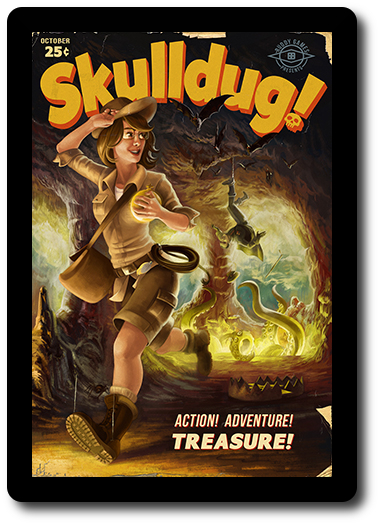
The Basics:
- For ages 7 and up (publisher suggests 13+)
- For 2 to 5 players
- Approximately 60 minutes (or more) to complete
Geek Skills:
- Counting & Math
- Logical & Critical Decision Making
- Reading
- Strategy & Tactics
- Risk vs. Reward
- Hand/Resource Management
Learning Curve:
- Child – Easy
- Adult – Easy
Theme & Narrative:
- If you are greedy, you best be speedy.
Endorsements:
- Gamer Geek mixed!
- Parent Geek approved!
- Child Geek approved!
Overview
Fictional character Indiana Jones taught me two things: history is cool and there is no problem in this world that a bullwhip can’t solve. Also, satchels (or man-purses) are cool. In the real world, archaeology is not about running around, fighting evil forces, and recovering cursed artifacts. Boring. Luckily, this game is.
Skulldug!, designed by Jon Gill, Brian Kopleck, and to be published by Ruddy Games, is comprised of 50 Passage cards, 47 Fortune cards, 31 Hazard cards, 5 Turn Action cards, 5 Dazed cards, 5 Explorer tokens, 25 Health gems, and 1 six-sided die. As this is a review of a prepublished game, I will not comment on the game component quality. The illustrations by Ghia Mercado are colorful and stylized, giving the game a Saturday Morning Cartoon kind of feel, which many of our players (especially the Child Geeks) enjoyed.
Pre-Exploration Preparation
To set up the game, first find the “Cave Entrance” Passage card and place it face-up in the middle of the playing area. Make certain the four-way intersection is showing. Skulldug! is best played on a large table if you can manage it, as players will be building many twisting tunnels and passageways, requiring a large playing area to contain the complex cave system.
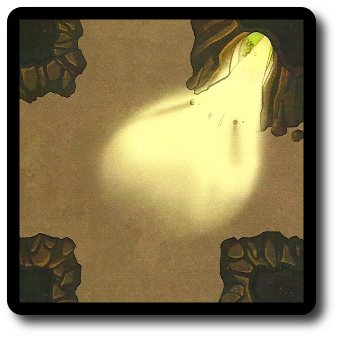
Second, have each player roll the six-sided die. The player with the highest roll (re-roll if there are ties) is the first player. Beginning with the first player and continuing clockwise, have each player select 1 Explorer token of their choice. Any Explorer tokens not selected are placed back in the game box.
Third, give each player their Explorer’s starting items and 5 Health gems. All remaining Health gems are placed in a pile off to one side of the game playing area. This is the Health gem pool for the duration of the game. I highly recommend you place the Health gems in a bowl, as the available playing area will gradually decrease in size as the game is played. Moving a bowl is a lot easier than sliding a pile of small plastic bits.
Fourth, shuffle the Passage, Fortune, and Hazard cards separately. Place each pile face-down to one side of the game playing area to create the Passage, Fortune, and Hazard draw decks. Leave room for discard piles. Place the Dazed cards in a pile next to the three draw decks.
That’s it for game set up. Time to explore, find the treasure, and become famous…or dead.
Items, Treasure, Traps, Monsters, and Other Interesting Things You’ll Find in Caves
The caves are filled with treasure, traps, and things that like to bit. In short, it’s a dangerous place, but with great risk comes great reward.
Hazard Cards
The many hazards found in the caves are designed to either hinder or flat-out pulverize Explorers. “Monster” Hazard cards live within the boundaries of the Passage card they are found in and are very territorial..and weird. A wide variety of the macabre and bizarre creatures await to ambush Explorers. From shambling undead to evil male models. These creatures will not venture past their Passage card (i.e. they do not move) on their own, but they will not hesitate to attack any Explorer foolish enough to enter their domain and can be moved by other cards. Some “Monster” Hazard cards have special rules that always apply when encountering them. These are listed on the card itself.
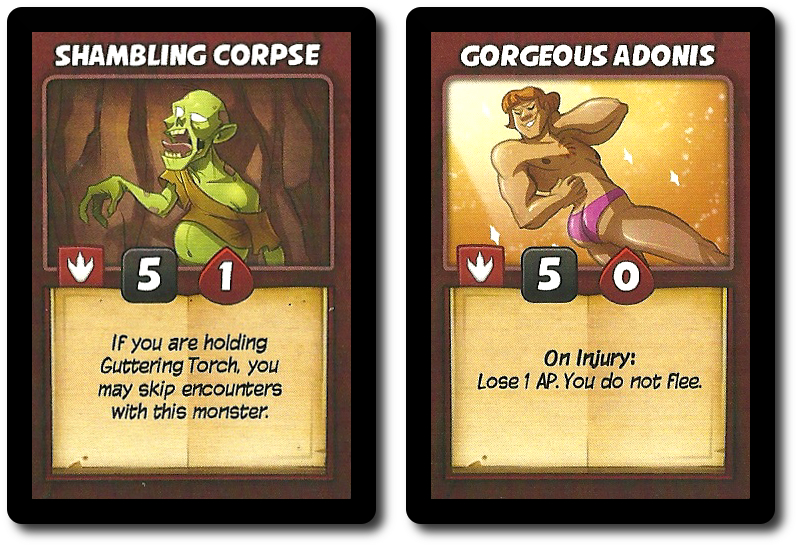
I honestly don’t know which one is more frightening…
“Trap” Hazard cards are like mindless monsters who simply don’t know when to die. Luckily, they can be picked up after they are encountered and placed in other Passage cards for opponents to stumble upon and enjoy. This makes the “Trap” Hazard cards like a fun, albeit deadly, toy.

When an Explorer token moves into a Passage card with a “Trap” or “Monster” Hazard card, it triggers an encounter that must be immediately resolved. Players complete the following steps.
- Spend Action Points (AP) for Focus bonus if needed (explained below).
- Roll the six-sided die and add any Focus bonus to it.
The resulting value is then compared to the “Monster” or “Trap” card difficulty value. If the resulting value is EQUAL TO or HIGHER than the listed difficulty value, the “Monster” card is discarded and the “Trap” Hazard card is added to the player’s hand.
However, if the resulting value is LESS than the difficulty value, the “Monster” or “Trap” card lists the number of Health gems that are removed from the Explorer. Some Hazards also inflict additional negative effects.
If a Passage card has more than 1 “Monster” or “Trap” card, all Hazard cards must be encountered and resolved. Start with “Trap” Hazards and then the “Monster” Hazard cards. Only those “Monster” and “Trap” Hazard cards in a Passage card the Explorer moves into are encountered. Meaning if the player starts their turn with their Explorer in the same room as Hazards, they are not encountered.
Optionally, a player can “Flee” from the Passage card after encountering a “Monster” or “Trap”. Regardless if the encounter was successful or not, the Explorer token can be moved to the previously occupied Passage card for free.
Fortune Cards
Risking life and limb would be a terribly stupid idea if it weren’t for the possible chance to get ridiculously wealthy. Greed and the quest for fame, it seems, trumps common sense and basic survival instinct.
“Equipment” Fortune cards represent the many tools and helpful gear the Explorer will need to take with them, find, and use if they are to succeed, let alone survive. “Equipment” Fortune cards give bonuses and some even provide new actions. They are not consumed when used, but a player is limited to the total number of cards they can have in their hand.
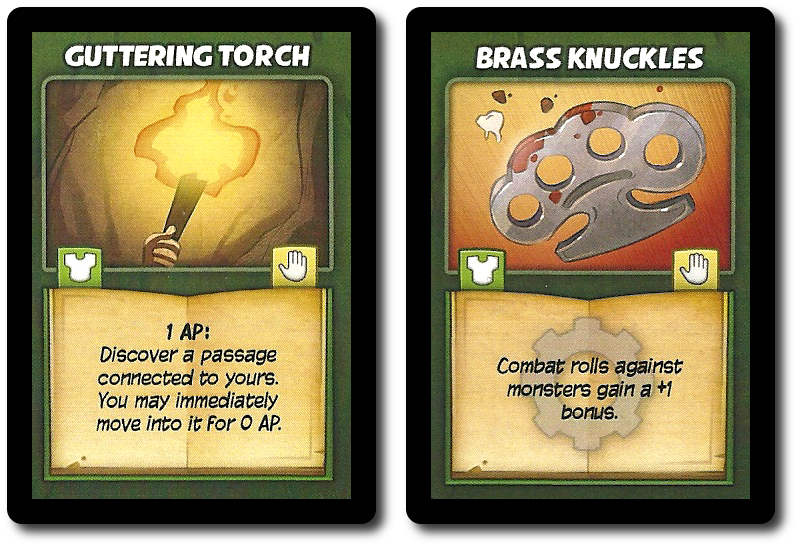
“Consumable” Fortune cards are one-shot bonus maker. They are used and then removed from the player’s hand. Rules for when the “Consumable” Fortune card can be used are noted on the card itself. A player is never required to use a “Consumable” Fortune card, but players should keep in mind that unused Fortune cards are worthless in the afterlife.
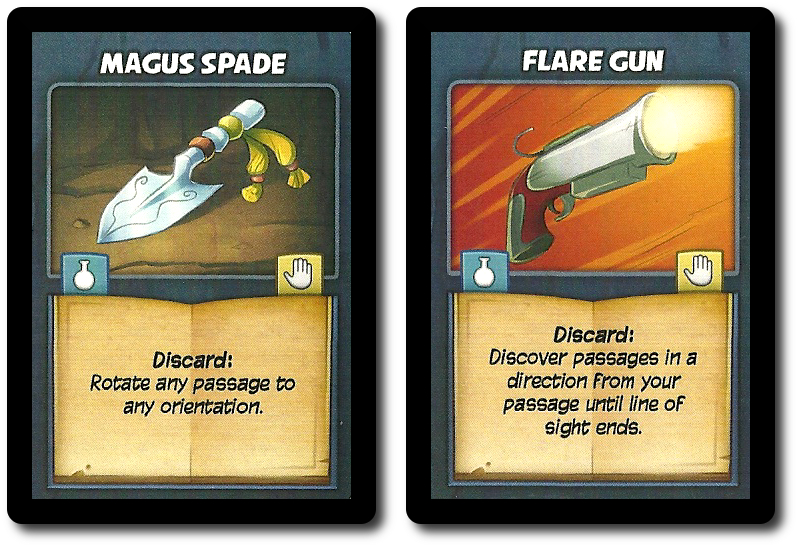
“Treasure” Fortune cards are the reason why the Explorer has put their life in great jeopardy. Each claimed treasure will get the player closer to victory, but at a price. Each treasure found in the caves has a curse which immediately affects the Explorer. Treasure also takes up space in the Explorer’s backpack, meaning the player will have to reduce the number of cards they can hold in their hand. So go right ahead. Pick up that jeweled crystal skull that causes your face to melt. I hear it’s worth billions…
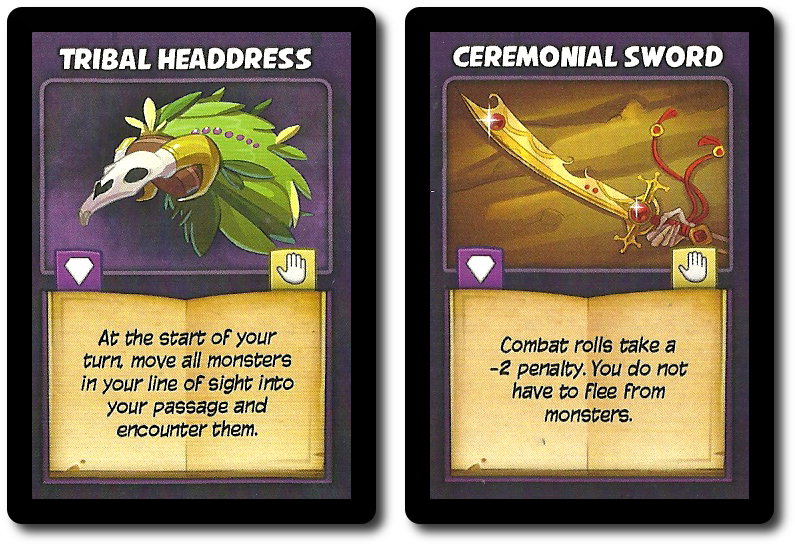
Health, Death, and Feeling Dazed
Every Explorer starts the game with 5 Health gems. As long as an Explorer has health, they are able to explore the caves, find treasure, and cause trouble. The maximum health an Explorer can ever have is 5, but if the total number of health ever drops to 0 or lower, the Explorer perishes doing what they loved. When an Explorer passes, the following steps are immediately taken.
- Any cards in the player’s hand are dropped on the Passage card for others to pick up.
- Dazed cards and any other status effects on the Explorer are removed.
- The Explorer token is removed from the game temporarily.
- The player’s turn is over.
On the player’s next turn, backup arrives. The player is given another 5 Health gems and their Explorer token is placed on the “Cave Entrance” Passage card. Then the top Fortune card is drawn. The player can either place this in their hand or drop it on the Passage card. The player’s turn then continues as normal.
An Explorer can become dazed for any number of reasons. This status effect is recorded by using the Dazed card. This card does not count towards the hand size limit but it is a nuisance. Dazed Explorers CANNOT take the Dash action and must subtract 1 from whatever dice values they roll. Luckily, a player can remove the Dazed effect by spending 2 AP (explained below).
Cave Exploration
Skulldug! is played in rounds and turns with no set number of rounds per game. A round begins with the First player and game play continues in turn order sequence. Each player has 3 AP to use on their turn. Each of the available actions are summarized here and each action can be used more than once per turn (with the exception of Shove and Destroy). The only limiting factors are the Explorer’s health, available AP, and opportunity.
Move (1 AP per Passage Card)
Movement within the complex cave is done by moving from one Passage card to another. Movement follows the illustrated passageways on the Passage cards, meaning a player cannot move their Explorer token from one Passage card to another if they are not connected with an open passageway. Some Passage cards have persistent effects that must be resolved when the player’s Explorer enters them. If the Passage card is home to any “Monster” or “Trap” Hazard cards the player’s Explorer must encounter them, as well.
Moving from one Passage card to an open space triggers exploration. A Passage card is drawn from the Passage draw deck and placed in the newly discovered space, thus expanding the cave system. When placing the newly discovered passageway, the card’s orientation is up to the player to determine. The only requirements is that at least 1 of the Passage card’s passageways must connect to the previously occupied Passage card (you cannot move through walls) and any remaining passageways must connect to as many other Passage cards as possible. Put another way, when placing the Passage card, the player is tasked to find the most optimal way to orientate the Passage card so as to connect as many of the passageways as possible.
Once the Passage card is placed, draw the number of Hazard and Fortune cards indicated on the Passage card. Place these cards face-up on the Passage card. These represent the treasure, gear, and traps the Explorer encounters. If one of the cards drawn is a trap or monster, it’s resolved immediately before any other actions can take place. If the room has a persistent effect, it’s also resolved.
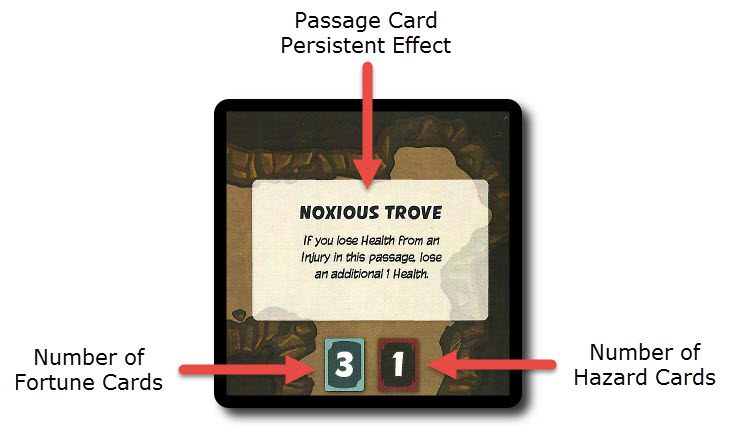
Dash (1 AP per 2 Passage Card)
This action allows the Explorer to travel through the cave system with a bit of speed, but only through discovered Passage card that do not contain any encounters (traps and monsters). This action cannot be used to travel through a Passage card that contains an encounter or if the movement of the Explorer token would result in discovering a new Passage card.
Pick Up (1 AP per Card)
Gear and useful equipment can be picked up by the Explorer if both the Explorer token and the item to be picked up are located on the same Passage card. Once the Item card is picked up, the player’s Explorer is affected by any of the item’s bonuses or penalties. When picking up the card, it’s placed in front of the player, face-up, for all to see. This is referred to as the player’s hand.
Drop It (0 AP per Card)
If a player has an item they no longer want their Explorer to carry, they can place it face-up on the Passage card their Explorer is currently located on or thematically “throw it” down the passageway to any other Passage card that is within the Explorer’s “line of sight”. A Passage card is in an Explorer’s line of sight if a straight and unbroken line can be drawn from the Explorer token’s base to the target Passage card. Only walls and undiscovered passageways break an Explorer’s line of sight.
Shove Explorer (Once per turn, 1 AP per Shove)
If an opponent’s Explorer token occupies the same Passage card as the player’s Explorer token, the opponent’s Explorer can be unceremoniously shoved to any adjacent Passage card. If the opponent’s Explorer token is shoved in a room with encounters, they must be resolved immediately, temporarily pausing the player’s turn. This includes shoving the opponent’s Explorer token into an undiscovered passageway which triggers the drawing and placement of a new Passage card. When the opponent is done resolving any encounters, the player’s turn resumes.
Focus (1 AP per +1 Die Roll Bonus)
At certain times, the player will be required to roll the dice to determine the outcome of an event. For example, an attack or defending against a monster. Dice are used to determine the level of difficulty and the results of attempting to overcome obstacles. For 1 AP, the player can give themselves a +1 bonus to whatever dice value is rolled. The player is welcome to spend as many AP as they like to increase the dice value.
Throw (1 AP per Card)
The Throw action is a lot like the Drop action, but with a very fun twist. This action allows the player to throw unwanted items at an opponent’s Explorer token. This action is a form of combat, where the Drop action is not. Line of sight is still used, but the dice are rolled to resolve the action. The following steps are taken by the player and the targeted opponent.
- The item card being thrown is placed in the Passage card where the opponent’s Explorer is located.
- The opponent rolls the six-sided die. The resulting value is the defense difficulty.
- The player spends any AP they like for a Focus bonus.
- The player rolls the six-sided die and adds any bonuses from their Focus action.
If the resulting total value of the die and Focus bonus is EQUAL TO or HIGHER than the defense difficulty value, the opponent’s Explorer removes 1 Health gem and drops 1 random card from their hand to the Passage card. If the resulting total value of the die and the Focus bonus is LESS THAN the defense difficulty value, the opponent’s Explorer takes no damage.
Destroy (Once per turn, 1 AP per Boom)
If the player wants, they can remove an unoccupied adjacent Passage card and send any cards it might contain back to their respective draw decks. The only restriction is that the Passage card to be removed must NOT contain an opponent Explorer token and MUST be reachable via a passageway. A special note on this second rule. The targeted Passage card to be blown up need not be accessible. A wall could be between the Explorer token and the passageway beyond. Thematically, the two Passage cards are close enough together to allow a stick of dynamite to do its job.
Players cannot blow up the “Cave Entrance” Passage card, but they can remove any Passage cards that are connected to it. If the blown up Passage card did contain cards, they are placed in their respective draw decks. Then the draw decks are reshuffled.
Other Actions
The action listed here are those available to all players. Certain cards found in the game offer the player new and unique actions to consider using, as well. Actions provided by cards still use AP and are resolved like any other action. For example, spending 2 AP to remove the Dazed card effect.
When the player is done taking their actions, their turn is over. If the player has 6 or more cards in their hand, they must Drop any number of cards so their total hand size is no bigger than 5. If any “Trap” Hazard cards are located in the “Cave Entrance” Passage card, they are discarded at this time.
Emerging Victorious!
The game continues until 1 player ends their turn on the “Cave Entrance” Passage card with 3 “Treasure” cards in their hand. This player is the winner and will most likely want to brag about it.
Game Variants
There are a number of ways to tweak the game play. Here are just a few.
Pace Yourself
During game set up, you can separate the purple “Treasure” Fortune cards from the Fortune deck and shuffle them individually, interspersing them in the larger Fortune deck. Doing so paces the game and reduces the chances of making the game feel longer than it should or shorter than you expected.
Personalized Gear
Each Explorer has a list of starting gear. These items are searched for and given to the players during the game set up. If the players like, they can instead equip their Explorer with items using a card draft. This is done by going through the Fortune and Hazard draw decks, removing each card that has a “gear” icon, and laying them out in 2 rows. The top row contains only equipment and the bottom row contains everything else. In turn order sequence, players can either take 1 equipment or any 2 cards in the bottom row. After everyone has selected their first card or cards, the turn order reverses and the process is repeated. The players now have their Explorer’s starting gear. Any remaining cards are shuffled back into their respective draw decks.
Exploration for Two
Skulldug! is played the same way with 2-players as it is for 3 or more players. The only exception is the game set up that requires the initial “Cave Entrance” Passage card to be placed with the “L” shaped passage showing. The Passage card is then placed in the corner of the playing area, thus defining the cave system’s building limits and boundaries.
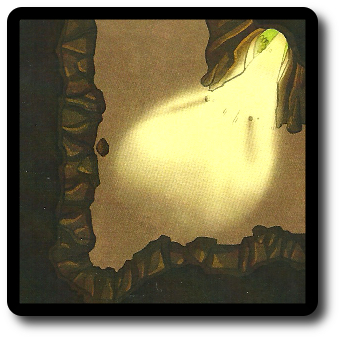
To learn more about Skulldug!, visit the game publisher’s website or visit the Kickstarter campaign.
Final Word
All of the Child Geeks understood how to play Skulldug! The only time the younger Child Geeks needed help was reading the cards and keeping track of how much AP was left to spend. Very minor in the grand scheme of things and resulted in no negative impacts to the game play since all the cards are always face-up. In other words, there is nothing to keep hidden or keep a Child Geek from playing the game. This helped a great deal and also was a lot of fun to watch the Child Geeks get up and look over their opponent’s should to read their cards. According to one Child Geek, “Whenever I see one of the other players with an item I want, I think to myself, I want that. Then I go hunt them down, knock them out and take their stuff!” Which really isn’t what the game is about, but the Child Geeks didn’t care. They saw Skulldug! as a game about running around, grabbing loot, and playing a strange form of tag. This highly amused them. Another Child Geek said, “I really like exploring and being the first to open a tunnel, but I hate it when I can’t roll the right number to beat the monster.” This came up often, but was never a strong issue. Which is to say, the Child Geeks, like all gamers, hate their dice. When the games were over and the treasure hoarded, all the Child Geeks voted to approve Skulldug!
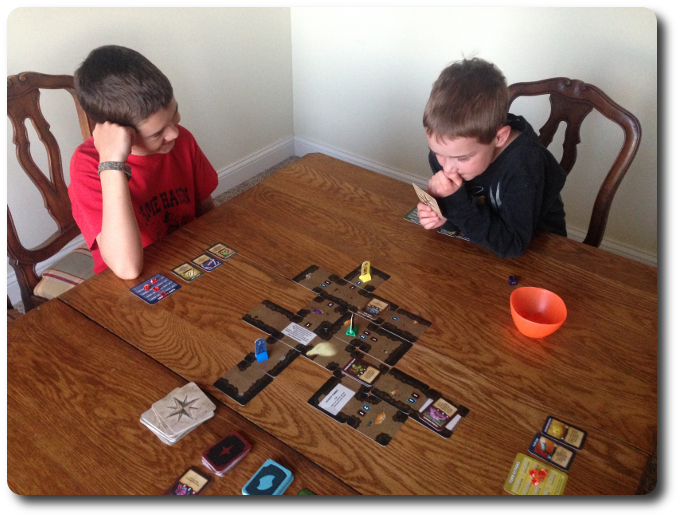
A new passageway is revealed, but how to place it? My son pauses to consider his options…
The Parent Geeks found Skulldug! to be good fun. According to one Parent Geek, “I think this is a great example of a family game that can be enjoyed by different gamer types and skill levels. My mom can play this and so can my kids. Best of all, they can all play it together.” Very true. Skulldug! has a very easy learning curve and the rules in the game are few and mostly condition-based. This leaves more time for the players to enjoy the game and less time looking up rule clarifications. Another Parent Geek said, “I almost think there is too much player versus player in this game, but I also don’t feel that the game is overly loaded with combative elements. You can attack your opponent if you like, but the game doesn’t say you have to. I guess that’s the best of both words.” Skulldug! is a game that can be very aggressive, but keep in mind that all actions require AP and AP is limited. If a player wants to go after an opponent they must be willing to sacrifice other actions. In this way, Skulldug! balances itself rather nicely, neither keeping the player on a leash, but not letting them run around unrestricted either. After the curses were lifted and Explorers returned to the game box, the Parent Geeks voted to approve Skulldug!
The Gamer Geeks found Skulldug! to be the very definition of a beer-and-pretzels type of game. Which is to say, the game’s light strategic game play and tongue in cheek humor paired well with the high level of randomness and luck based outcomes. Of course, this also meant that the game immediately polarized the gaming elitists into two groups: those who enjoy a game that is just meant to be fun and those who can’t be bothered to play a game that doesn’t take itself seriously. According to one Gamer Geek, “I rather like the game. It’s easy to set up, fun to play, and kept me on my toes. I think the pacing it a bit off at times, but I also think that is based on a player’s inability to take their turn quickly.” Another Gamer Geek said, “This is just a silly and fun game. Perfect for a heavier filler or just a casual game night. Not a terribly deep or imaginative game, but a fun one. I especially like all the nasty ways you can mess with an opponent.” The Gamer Geeks who did not care for Skulldug! were not shy about their opinion. As one Gamer Geek put it, “This game is a waste of time for anyone who wants to play a game that allows for meaningful game play. Everything is random or held hostage by the roll of a die.” Another Gamer Geek said, “This game reminds me of Dungeon! Kick a door in, reveal the room, fight monsters, and take the treasure. Rinse and repeat over and over again.” The Gamer Geeks were mixed when it came time to vote for Skulldug! Those who liked more casual games meant to simply entertain voted to approve it and those who wanted games to challenge them rejected it.
Skulldug! is all about tripping up your neighbor, in my opinion. You have to or you will lose the game. Because the treasures necessary to win are randomly revealed, a player must do all they can to be the first to find them or steal them. That means taking risks and doing everything possible to slow the opposition down. The player interaction is always aggressive, but light. Kind of like being in a pillow fight. You will get hit and become dazed at times, but never fully knocked out by an opponent unless the player is running around with only 1 Health gem. In which case, you are a moving target. Most of the time, players took themselves out temporarily by entering rooms they simply could not handle. And here is where the game lost some of the Gamer Geeks. It’s random. Very, very random. A player’s best bet is to equip what they think will be handy and then run like mad. That irritated some of the gaming elitists who wanted a game where creeping and skulking was matched with strategic prowess and stealthy tactics. Skulldug! is simply not that kind of game.
One of the aspects of the game play I really enjoyed was the mixing and matching of Fortune cards. You can create interesting combos with “Equipment” and “Consumable” items with neat effects. The challenge is knowing how best to use them and when. When the player finds a “Treasure” Fortune card, they might have to drop a reliable tool or weapon. Which is really too bad, because once you collect “Treasure” Fortune cards, you become a target. Victory in this game comes at a price and that price is security.
This is a very smooth game. It his highly random and luck plays a larger roll than I normally prefer, but the rules and the game play are solid. Despite playing the game many times, I have yet to feel like I am playing the same game. Each set up, reveal, and encounter is always different. The only thing that remains a constant from one game to the next is the player’s goal. A goal, I might add, that is not easy but is most certainly worthwhile to attempt. If Skulldug! sounds like a game you and yours would enjoy, do sit down and explore it. You might just find it’s a game you’ll treasure.
This is a paid for review of the game’s final prototype. Although our time and focus was financially compensated, our words are our own. We’d need at least 10 million dollars before we started saying what other people wanted. Such is the statuesque and legendary integrity of Father Geek which cannot be bought except by those who own their own private islands and small countries.



